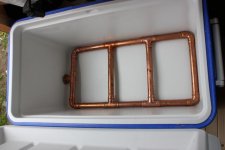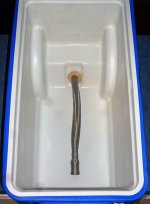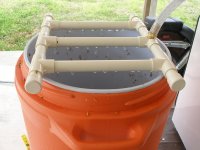I agree with all of the above. I've never done a fly sparge though. I do batch sparging.
I noticed though, in your original post, you did not specifically say that you fly sparge. You only stated that you would use a "Hot Liquor Tank" to put sparge water into you Mash Tun, while slowly draining wort out. Do you "fly sparge" or do you "batch sparge"? I'll go into the differences for those reading through this that don't know the differences.
Do you have a fly sparge arm that sprinkles the hot sparge water evenly over your Mash? If yes, then this is "fly sparging". If you don't, then basically, you're doing a kind of continuous batch sparge.
To take advantage of the increased efficiency potential of "fly sparing", two pieces of equipment are required.
- You need a "fly sparge arm", (as mentioned above), to sprinkle the sparge water evenly over the top of the grain bed.
- You need some type of system at the bottom of the mash tun that will drain the wort out evenly from the entire bottom of the mash tun.
I've posted two photos of ways to drain from the bottom.
One is a series of interconnected copper tubing that will drain evenly over the entire bottom of the mash tun. These can be made for "round" cooler mash tuns, just as easily. This is the type of set up you would use for fly sparging. It can also be used for batch sparging.
The other photo is of a bazooka screen. This won't drain evenly over the entire bottom of the mash tun, which will leave some sugars in the grain at the sides. If you use this, with a fly sparge arm, you probably won't get much of an increase in efficiency from the fly sparging. The reason you'll won't get much increase in efficiency (and can sometimes even get a drop in efficiency), is because when you sprinkle the water over the tap, but drain from a single area of the bottom, the water will tend to channel straight down to the bazooka screen and most of the sparge water won't filter through all of the grain bed. The rest of the grain bed only drains out at the very end, thus leaving a lot of sugar behind in the grain.
The last photo is a "fly sparge arm". Notice how it sprinkles the hot water over the entire grain bed.
The secret to fly sparging is evenly added hot water to the entire grain bed and evenly drained wort from the entire grain bed. All of my friends that fly sparge state that you want to drain it as slowly as you can stand to drain it, when fly sparging.
As far as "batch sparging" is concerned, my procedure is described in detail on my blog site here. >>>> https://creativebrewing.wordpress.com/brewing-articles/all-grain-my-mashing-process/
I've found that the things that helps me get the best efficiency from my batch sparging are:
- Good grain crush! All grains crushed, so that the insides of each grain are exposed. But not so finely crushed as to make powder.
- Recirculation!! Slow, slow, slow recirculation I've found is key for me. If I rush lautering too much and don't recirculate enough, then my efficiency can drop by as much as 10%!!!!! I try to run about 2.5 to 3 gallons of lauter back through the system, before draining.
- Others mentioned mash out temperature. For me, I get about a 3% boost in efficiency when I raise the temperature of the mash up to 168F, before lautering and draining. Which makes sense when you think about it. Sugar dissolves more readily in hotter water, than it does in colder water, so it stands to reason that the wort will be a little higher in sugar concentration at this higher temperature. The way that I raise my mash temperature is explained in the above link to my all grain mashing process.
I hope that you found this helpful. Please ask any further questions you might have. We'd be glad to assist further.



